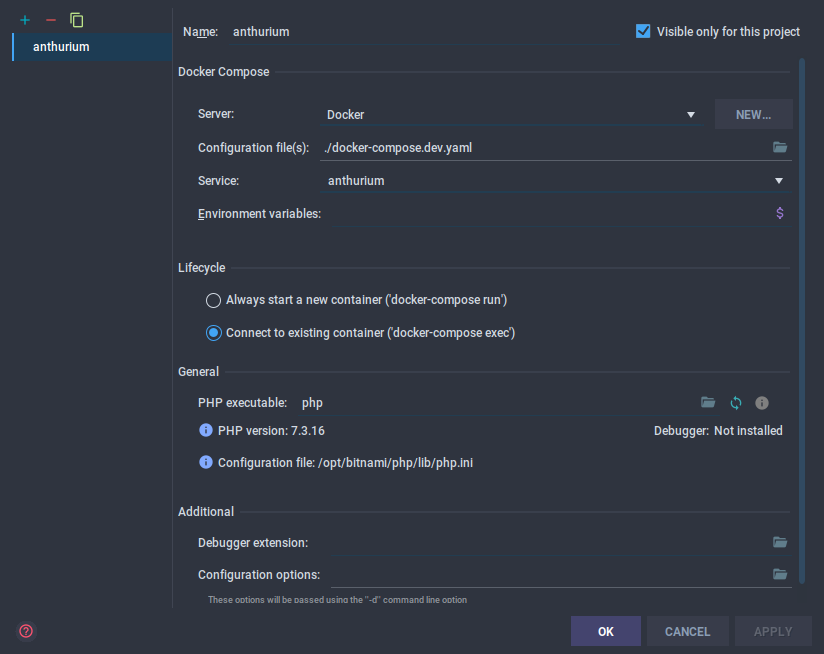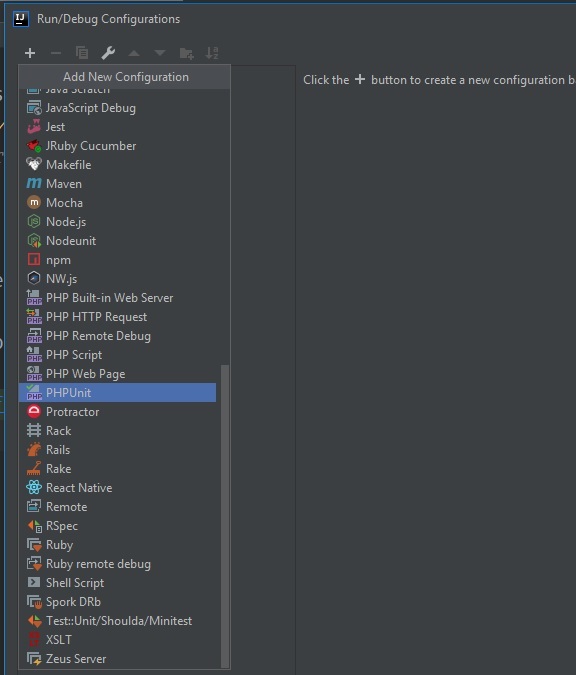- Phpstorm Xdebug Docker Cli
- Php Docker Xdebug Phpstorm
- Phpstorm Docker Phpunit
- Phpstorm Docker Xdebug Not Working
- Phpstorm Phpunit Dockery
- Phpstorm Run Phpunit In Docker
And ignore the warning. This is nothing to worry about, the ini file is simply in the container and not accessible by PHPStorm. Also set your PHPUnit settings like in the above and you’re pretty much there and should be able to run phpunit.xml files like with any other PHP + PHPUnit setup, while being able to easily jump around PHP versions. Configure PHPStorm's local server to point to your docker service by going to File Settings Languages & Frameworks PHP Servers. Add a new server and set the host to localhost and the port to whatever port you are publishing your docker-compose web service to. PhpStorm offers so much functionality. From syntax highlighting to Docker integration, it’s an extremely comprehensive tool. However, have you ever thought of using it to run your unit tests? In this article, I step you through running tests, from an entire suite to an individual test.
Early Access ProgramFeaturesTutorialsDocker is an open platform for building, shipping and running distributed applications. It gives programmers, development teams and operations engineers the common toolbox they need to take advantage of the distributed and networked nature of modern applications.
With the new Docker integration plugin for PhpStorm, you can add Docker support to existing projects, view logs, manage Docker containers, and debug PHP web applications from right inside PhpStorm.
In this blog post we overview some of the most important features and configurations; for more details please refer to the full tutorial on Docker Support in PhpStorm.
Prerequisites
First of all, you’ll need to install Docker and related tools so that you can take advantage of the Docker integration in PhpStorm. Please refer to the Docker documentation to get more information about the installation process for various platforms or the cloud.
You will also need to install the Docker integration plugin in PhpStorm (in Settings /Preferences | Plugins, click the Install JetBrains plugin…).
PhpStorm & Docker Integration Configuration
To start using Docker, the default Docker machine should be launched using the Docker Quickstart Terminal (Windows / Mac OS X, for Linux you need to use a standard terminal executing asudo docker run hello-world command). At the next steps we’ll need some of the parameters of this machine environment, so we’ll need to run docker-machine env default console command to get all the necessary parameters (Windows / Mac OS X, for Linux you’ll need to use a standard IP address 172.17.42.1), such as DOCKER_HOST and DOCKER_CERT_PATH:
As soon as we have Docker running (and all the parameters fetched for future use), we can start configuring PhpStorm to work with Docker.
Create a Docker configuration with the + button in Settings / Preferences | Build, Execution, Deployment | Clouds:
We’ll need to provide the configuration name (Docker), API URL (https://192.168.99.100:2376, taken from the previous step), and Certificates folder (/Users/mikhailvink/.docker/machine/machines/default).
Please note that you will need to provide a socket path in the API URL field on Linux machines (unix:///var/run/docker.sock by default).
Next we need to create a new Docker Deployment Run/Debug Configuration in the Run | Edit configurations… menu.
Provide all the necessary parameters on the Deployment and Container tabs:
At this point we are interested in exposing port 80 of the container to be available from our local machine, so we should configure a port binding for that:
There are many ways to create/configure Docker containers and VM images; please refer to the Docker documentation on their official website.
For the purposes of this tutorial we’re making some configuration in the Dockerfile and Apache configuration file, so do have a look at them. You can download the entire project used in this demo or separate config files (apache-config.conf, Dockerfile) which then need to be placed in the project root folder.
Running the Docker from PhpStorm
As all the tools are installed and the integration is configured, the recently created Start Docker Run/Debug Configuration can be launched. The Application Servers tool window will be opened updating you on the provisioning status and current state of all your Docker containers:
As soon as our Docker_Xdebug container’s status turns green, we can check how it works in the browser. You should be able to open it with a URL similar to http://192.168.99.100:8080/ (http://host:port, 192.168.99.100 is the IP address of the default Docker machine).
Managing Docker containers and other Docker-related actions in PhpStorm

From the Application Servers tool window, it’s easy to inspect containers and view the running processes. You can also search through logs, start and stop containers, and perform basic container management like creating and deleting containers.
Debugging PHP web application running in the Docker container
The main challenge in getting Xdebug (or Zend Debugger) working with PhpStorm and Docker integration is the correct configuration of the Docker container.
In our case we’re using a Dockerfile (we’ve already shown this config earlier and provided links to download it) to configure the container, including Xdebug-specific parameters, such as:
Phpstorm Xdebug Docker Cli
RUN echo 'zend_extension=/usr/lib/php5/20131226/xdebug.so'>> /etc/php5/apache2/php.iniRUN echo 'xdebug.remote_enable=1'>> /etc/php5/apache2/php.ini#Please provide your host (local machine IP) instead of 192.168.2.117RUN echo 'xdebug.remote_host=192.168.2.117'>> /etc/php5/apache2/php.ini |
Please note that xdebug.remote_host value should be replaced with your local machine IP address which is visible from the Docker container (where PhpStorm is running, in our case 192.168.2.117).
Don’t forget to re-run Start Docker Run/Debug Configuration so that all the changes are applied.
As soon as all the configs are in place, the debugging process can be triggered by following this tutorial starting with step 2 (start Listening for PHP Debug Connections, set a breakpoint in the source code, and start a debugging session in the browser, reload the current page, debug) to get the debugger up and running in a few moments:
Please have a look at the full tutorial on Docker Support in PhpStorm for more information.

Please share your feedback on Docker support in PhpStorm in the forum, comments to this blog post, or our issue tracker. Thanks!
Develop with pleasure!
JetBrains PhpStorm Team
I wanted to run tests with PHPUnit on a docker environment, which was set up with docker-compose, and use the PhpStorm integration. Since PhpStorm 2013.2 there is a docker intergration which works well for single containers, but unfortunately it does not seem to use the running network of containers. So for example my PHP container does not get access to the MySQL container for integration tests.
If that’s not a problem for you, you will not need what I am going to explain here, read this instead: https://blog.jetbrains.com/phpstorm/2016/11/docker-remote-interpreters/
Local CLI Interpreter
So instead of configuring the Remote PHP Interpreter for Docker, I created a local interpreter like this and selected it as the CLI interpreter for the project:
The interpreter is actually a shell script that runs PHP in my container using docker-compose run. PhpStorm will not know that it runs in a container. I got the idea from this article and adapted it for docker-compose.
Php Docker Xdebug Phpstorm
This is the test.sh script:
Where “integration” is the name of the container.
docker-compose Configuration
For me the “integration” container is defined like this in docker-compose.yml:
Yours will look different, whatever the needs of your PHP container are. But the two highlighted lines that are important for the PhpStorm integration:
- PhpStorm writes a temporary test runner to
/tmp, so we mount the host /tmp directory to the container - The project directory must be mounted to the exact same path as on the host because there are no path mappings for a local interpreter and host paths will be passed to PHPUnit
Integrate the Test Runner
Now when you run a test file, or a phpunit.xml configuration in PhpStorm, the path is passed to our fake interpreter (test.sh) and …
Cannot find PHPUnit in include path
This error caused me some headache. I finally found out that the test runner that is generated by PhpStorm looks for “../../vendor/autoload.php” or “../../../vendor/autoload.php” within the include path. I’m not sure why it works like this, it seems to assume that it is run with the directory of the “phpunit” executable as working directory. Since “.” is usually in the include path, it finds the correct composer autoloader from there.
On the docker container this is not the case (the working directory on the host does not matter here). I tried to change the working directory there but in the end it was easier to change the include path in the “Run/Debug Configuration”:
Interpreter options:
Now it works!
Phpstorm Docker Phpunit
PhpStorm runs the command like this:
which results in this command being executed on the container:
Phpstorm Docker Xdebug Not Working

Phpstorm Phpunit Dockery
If you mounted the paths correctly and the container is running, the tests will run on the container and PhpStorm “thinks” they run locally.
Phpstorm Run Phpunit In Docker
Related Posts:
